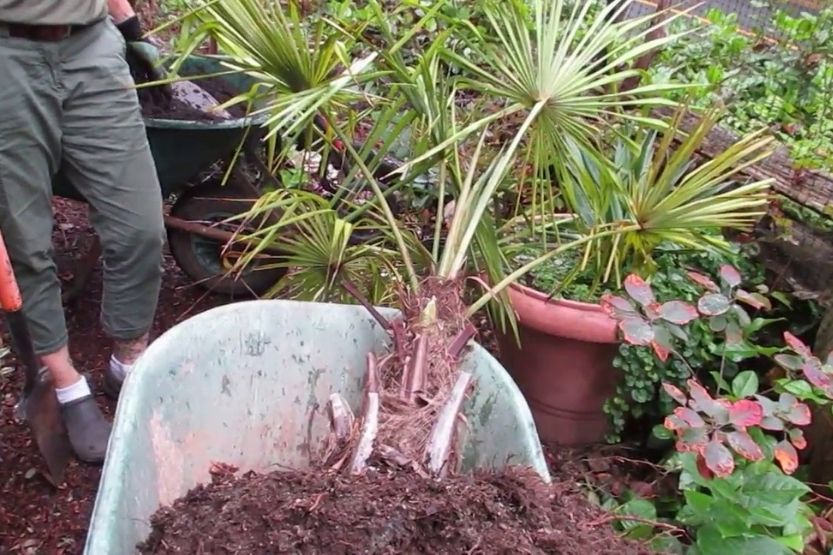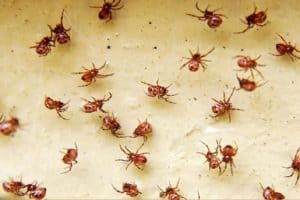Are you itching to plant a few decorative palm trees in your yard? Palm trees will really make your lawn look exotic. But what about their roots? Will palm tree roots be a problem? Will they cause damage? How deep does the palm tree roots’ system go?
On average, palm tree roots are not destructive compared to trees that have thick roots. Palm trees typically have roots that are too thin to cause any real damage. These roots are fragile and narrow. Palm trees also don’t have big taproots at their base.
The root system of palm trees is fibrous. The roots are not deeply embedded in the soil. These roots usually spread over the soil like a mat. Their typical maximum soil penetration is around 36 inches of the topsoil.
Read on to learn more about palm tree roots, as well as how deep the palm tree roots’ system grows, and other important things you need to know if you want to plant them in your yard.
Palm Tree Roots – Are They Problematic?

The roots of palm trees pose no considerable damage to your property. Their roots are so thin and shallow growing that they won’t damage the structures near them. Compared to the roots of other trees, these roots are too narrow.
Palm trees can grow from thirty to a hundred feet. But their roots only develop in the top 36 inches of topsoil. The palm tree roots system does not have long and deep taproots like most trees. They have significantly thin roots that grow horizontally and spread outward from the base of the tree.
How deep are palm tree roots? The root system of palm trees is fibrous. They don’t penetrate the soil too deeply but spread out from the tree’s base like a mat. The maximum depth that these roots can penetrate is about 36 inches.
The roots of palm trees can also be easily recognized because they are very distinct. However, as palm trees mature, they develop a secondary root system. It could form near or above the soil level.
This shallow root system’s fibrous and prolific character makes it difficult for other plants to grow around and near the base of palm trees.
How Do Palm Tree Roots Grow?
Compared to other trees, the roots of palm trees are very distinct. These trees have a fibrous root system meaning the roots are like fibers that are thin and narrow. From the base of the root ball, the roots grow in thin strands. They spread outward from the base of the tree.
It’s usual for them to be seen above ground. These roots remain thin, and they regenerate regularly. They eat the soil nutrients and expand from the base in search of water. The root balls of palm trees don’t grow too big compared to their full height upon maturity.
Most trees have a tap root system that consists of one primary root, which produces several thin lateral roots. With palm trees, the roots come out from the tree base. These roots and the base are similar morphologically, meaning their form and structure are the same.
As the tree gets taller, the individual roots don’t grow wider. They maintain the same girth as they grow older. Regardless of the palm tree’s height and age, its roots do not grow bigger in their girth.
They just spread horizontally from the palm tree base and remain at the soil’s surface, between 12 and 36 inches of the topsoil. Some palm trees have roots that spread out 50 feet from the base, and they are still thin all the way.
How Deep Are Palm Tree Roots – How Far Do They Grow?
Since palm trees’ roots grow near the soil’s top surface, the typical palm tree roots’ depth is not that considerable. The typical palm tree’s root system usually penetrates the top 36 to 40 inches of the soil surrounding its base.
On average, palm trees that are less than 16 feet (5 meters) tall will have root balls up to 24 inches in diameter. That means the root system of a palm tree that is 16 feet tall will be approximately two feet deep (6.5 m.) and two feet wide.
Since palm trees’ roots only grow on the upper soil level, they can reach far away from the tree. This root system enables them to get enough nutrients and moisture to grow and be productive. The longer the roots, the more stabilized and well-fed the palm tree will be.
Do the Roots Grow as Big as the Palm Tree?

Unlike other trees’ roots, the palm tree roots’ depth does not grow as big as the palm tree. They only extend their lengths outward and radially from the base of the palm tree.
A root can be 5 feet or 10 feet or even 20 feet long, but its girth near the tree’s base will be almost the same size as the girth near its farthest extension.
These roots start forming from the base of the tree. This area is called the root-initiation zone. The roots grow continuously and die off from this root zone. They regularly regenerate, so they don’t grow as long or as wide as their mother tree.
Functions of Palm Tree Roots’ System
Without their roots, trees will wither, dry, and die. If you are thinking of growing them in your yard, you need to know why palm trees have this root system:
- The roots anchors and stabilizes the long trunk of the palm tree so it will remain standing;
- They absorb dissolved minerals from the ground, such as manganese, iron, and magnesium. Palm trees need these minerals so that their fronds will remain healthy and green;
- They keep the palm tree hydrated by absorbing moisture from the ground;
- The roots conduct the absorbed moisture and nutrients from the base to the trunk and up to the fronds to maintain their health;
- They bind the soil where they are planted with their fibrous strands making the soil more stable and resistant to erosion; and
- These roots also have medicinal values. They can help people suffering from fibrosis.
For this purpose, boil 3 to 5 roots in water. Drink this tea after it has cooled down. These roots are also used to treat kidney and gall bladder problems as well as urinary tract infections.
About 4 to 5 roots can be boiled in water to treat gall bladder and kidney problems. Drink this root tea when it has cooled down. They can also treat heartburn and can help in melting clotted blood.
What Would Happen If I Remove the Roots of a Palm Tree?
Is removing palm tree roots good or bad for the palm tree? How will it affect the health and growth of the palm tree? As long as the root cuts are not too close to the initiation zone or the tree’s base, there will be no significant effect on the tree.
When replanting a palm tree, it is advised not to cut extensive lengths of the roots. At least three to six feet of roots should be left untouched from the initiation zone.
Additionally, you should cut the exposed roots two months before transplanting them. In that way, the tree will have enough time to adapt before it is transplanted.

Again, palm tree roots-are they problematic? Palm tree roots are usually not problematic since they are narrow and thin. Thus, it cannot damage your property.
FAQs About Palm Tree Roots
Can the Roots Destroy Pipes?
Given the nature and characteristics of palm tree roots, it is doubtful to destroy pipes. They are not like the roots of other trees that grow big in girth and length and go deep and everywhere.
The roots of palm trees remain in the topsoil near and around the tree. They don’t go deeper than 36 to 40 inches below ground. With that kind of reach, their small girths, and their soft tissues, it will be difficult for them to cause palm tree roots damage to underground pipes.
There are rare cases where these roots have reached the pipes below ground and got entangled. But this only happens with large species of palm trees.
At any rate, if you are planting a palm tree in your yard, you are advised to leave 11 to 12 feet of space between a large palm tree and the pipes to ensure that there’ll be no problems in the future.
Here is another thing that you need to consider with regards to planting palm trees near any pipework. If the pipe is leaking, the roots of the palm tree will gravitate toward that leak.
Remember, these roots are mostly near or above the soil surface. If the leaking pipe is not plugged, roots can grow in the pipes. And that would be a problem.
Can Palm Tree Roots Damage Concrete?
It is doubtful that the roots of a palm tree can destroy hard concrete. These roots are soft, and they are too thin and narrow that they can’t break into hard concrete unless the structure has cracks or is full of visible holes. The roots are not strong enough to push themselves against concrete.
The diameter or girth of these roots stays the same all the life of the mother tree. As the palm tree matures, its roots maintain their narrow and thin size. In other words, they don’t pose an acute danger to concrete and other hard surfaces.
However, if you don’t want to take the chance, plant the palm tree 12 feet away from a concrete floor or wall. That will provide enough distance for the roots to spread away far from any hard surface in your house.
Are the Roots of Palm Trees Invasive?
While most palm trees’ roots grow far out from their initiation zone, they are still considered non-invasive. There is no need to worry about these roots causing the kind of damage that other tree species are known for.
However, if you plant a palm tree in a small garden, the other plants in the area might be affected. The palm tree will eat most of the nutrients and absorb most of the garden’s moisture, leaving the other plants only a small portion of the food and moisture they need to grow.
One way out of this situation is to choose a smaller species of palm tree. The root system of the smaller palm tree will not be as big as the bigger species. It will be easy to manage and control the root system’s growth.
Exposed Roots – Are They a Problem?
The roots of palm trees start growing in what is called the initiation zone. This area could be below the ground or, in some cases, above ground. Some palm tree species’ root initiation zone can extend several feet from the ground to the tree’s trunk.
In other words, it is not unusual to find palm trees with their root system exposed. If the moisture is not sufficient in the area, the roots may stop growing. They will only start growing again if enough moisture is present.
Palm tree roots exposed above ground do not pose a significant problem. However, if the roots are infected with the disease, the tree’s health will be affected. To prevent this problem, the exposed roots should be pruned.
How to Kill Palm Roots?
To kill palm roots and remove a palm tree in your garden, here are the steps you can follow:
- Expose your palm tree roots by pouring water to the ground;
- After exposing the palm tree roots system, use a pruning saw and cut the roots;
- Repeat steps one to two if needed until you can take out the palm tree from the ground;
- To make sure that you get all the palm tree’s roots, dig the surrounding area; and
- Lastly, once clear, flatten the area and plant the area with other plants.
Conclusion: Palm Tree Roots System – Are They Problematic?
In general, the roots of palm trees do not pose significant problems. They are not destructive as compared to other trees that have thicker roots. The roots of palm trees are too thin to cause any real damage to your property. Their roots are too narrow to cause problems.
Unlike other tree species, palm trees also don’t have big taproots at their base. While the root system palm trees are just beneath the topsoil, with some even above ground, they are still considered non-invasive.
Again, to remove the palm tree in your garden, here are the steps you can follow:
- Expose your palm tree roots by pouring water to the ground;
- After exposing the root system, use a pruning saw and cut the roots;
- Repeat steps one to two if needed until you can take out the palm tree from the ground;
- To make sure that you get all the palm tree’s roots, dig the surrounding area; and
- Lastly, once clear, flatten the area and plant the area with other plants.


![Read more about the article Tiny Black Bugs in Bathroom [What Are They? How to Get Rid of Them?]](https://howchimp.com/wp-content/uploads/2021/05/tiny-black-bug-in-bathrooms-6-300x200.jpeg)
